Mexican Red Knee Tarantula
- March 13, 2024
- 0 comment
The Mexican Red Knee Tarantula, scientifically known as Brachypelma hamorii, is a stunning arachnid species native to the scrublands and deserts of western Mexico. Renowned for its striking appearance, this tarantula species boasts a black body adorned with vibrant reddish-orange patches on its knees, creating a visually captivating contrast. With a leg span reaching up to 6 inches for females, and slightly smaller for males, these tarantulas possess a robust physique covered in fine hairs, lending them a velvety texture.
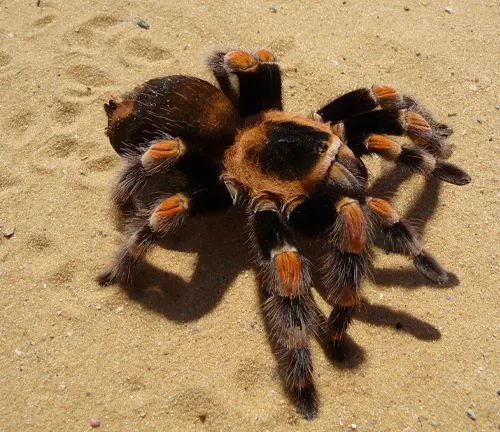
Despite their intimidating appearance, Mexican Red Knee Tarantulas are known for their docile nature and are a popular choice among arachnid enthusiasts. They play a crucial role in their ecosystems as nocturnal hunters, preying on insects and small vertebrates, contributing to the natural balance of their habitats. While once abundant throughout their range, Mexican Red Knee Tarantulas face threats from habitat destruction and over-collection for the pet trade, prompting conservation efforts to protect their populations. Overall, these fascinating creatures continue to captivate the interest of enthusiasts worldwide with their beauty, behavior, and importance in the ecosystem.
| Specification | Description |
|---|---|
| Scientific Name | Brachypelma hamorii |
| Common Name | Mexican Red Knee Tarantula |
| Family | Theraphosidae |
| Size (Adult Female) | 5 to 6 inches (leg span) |
| Size (Adult Male) | Slightly smaller than females |
| Coloration | Black body with vibrant reddish-orange knees |
| Habitat | Scrublands and deserts of western Mexico |
| Range | Specific regions of Mexico |
| Behavior | Nocturnal; docile nature; prey on insects |
| Lifespan | 15 to 20 years or longer in captivity |
| Threats | Habitat destruction, over-collection for the pet trade |
| Conservation Status | Not currently listed as endangered; facing threats |
The Fascinating World of the Mexican Red Knee Tarantula
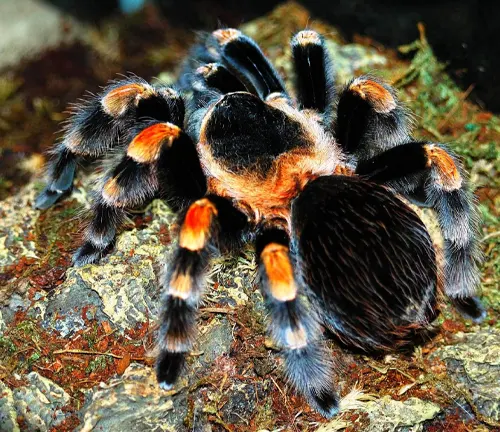
The Mexican Red Knee Tarantula, scientifically known as Brachypelma hamorii, is one of the most iconic and sought-after tarantula species in the world of arachnid enthusiasts. With its striking appearance and intriguing behaviors, this species has captivated the interest of both hobbyists and researchers alike. Let’s delve into the world of the Mexican Red Knee Tarantula and uncover its unique characteristics.
Physical Description
Size and Appearance
Mexican Red Knee Tarantulas exhibit a notable sexual dimorphism, with females typically larger than males. Adult females generally have a leg span ranging from 5 to 6 inches, while males are slightly smaller. They possess a robust and stocky body covered in fine hairs, giving them a velvety texture. Their eight legs are segmented and end in sharp claws, which they use for climbing and capturing prey. Additionally, Mexican Red Knee Tarantulas have two prominent pedipalps near their mouthparts, which aid in sensing and manipulating objects.
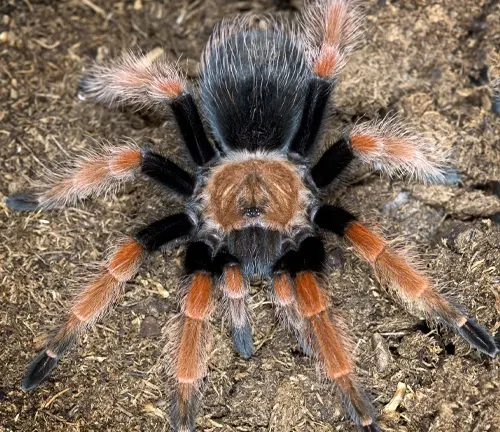
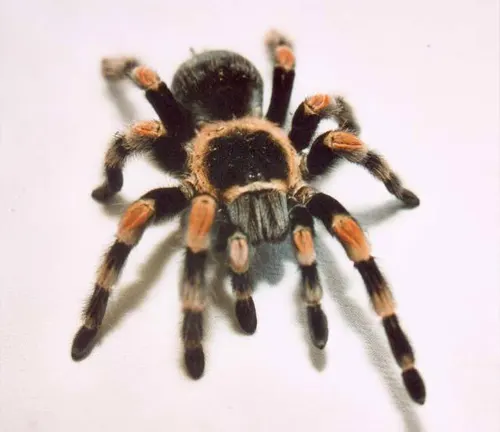
Coloration
One of the most striking features of Mexican Red Knee Tarantulas is their vibrant coloration. Their bodies are primarily black, providing a stark contrast to the bright reddish-orange patches on their knees. These distinctive markings extend along the joints of their legs, creating an eye-catching display. The abdomen of Mexican Red Knee Tarantulas often features intricate patterns of stripes and spots, adding to their overall aesthetic appeal. This bold coloration serves as a form of aposematism, warning potential predators of their venomous capabilities.
Habitat and Distribution
Natural Habitat
Mexican Red Knee Tarantulas are primarily found in the scrublands and deserts of western Mexico, where they inhabit burrows dug into the ground. They are well-adapted to arid environments, preferring dry and sandy terrain with sparse vegetation. These tarantulas construct elaborate burrows that serve as their shelters, providing protection from extreme temperatures and predators. Within their burrows, Mexican Red Knee Tarantulas create silk-lined chambers where they rest and molt. Despite their preference for arid habitats, they can also be found in other terrestrial ecosystems, including tropical dry forests and thornscrub.
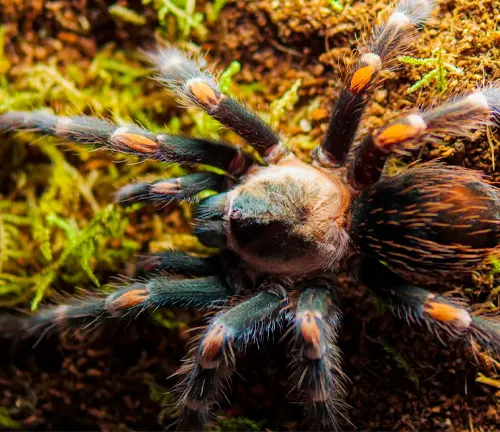

Geographic Range
The geographic range of Mexican Red Knee Tarantulas is primarily restricted to specific regions of Mexico. Historically, they were abundant throughout western Mexico, including states such as Michoacán, Guerrero, and Colima. However, due to habitat destruction and collection for the pet trade, their distribution has become more localized. Today, Mexican Red Knee Tarantulas are primarily found in isolated populations within their native range. Conservation efforts are underway to protect their remaining habitats and ensure the long-term survival of this iconic species.
Behavior and Lifestyle
Feeding Habits
Mexican Red Knee Tarantulas are opportunistic feeders, preying on a variety of insects, small vertebrates, and occasionally, other tarantulas. They are nocturnal hunters, relying on their keen sense of touch and sight to detect prey. When hunting, Mexican Red Knee Tarantulas will ambush their prey, immobilizing it with their venomous fangs before consuming it. Common prey items include crickets, grasshoppers, beetles, and small rodents. Despite their intimidating appearance, they play a vital role in controlling insect populations within their ecosystems.
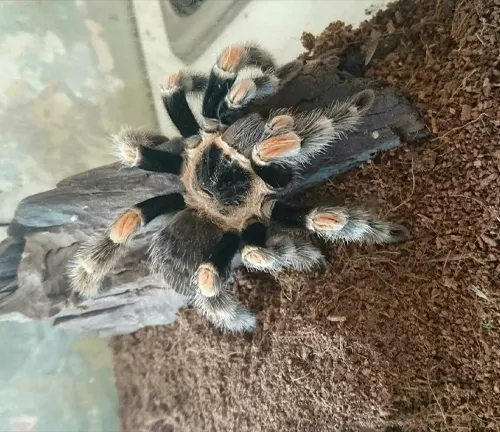

Reproduction
The reproductive process of Mexican Red Knee Tarantulas begins with courtship rituals performed by mature males to attract females. These rituals often involve intricate displays of tapping and drumming on the ground or the female’s burrow entrance. Once a receptive female is found, mating occurs, with the male transferring a sperm packet to the female’s genital opening. After mating, females will create an egg sac containing hundreds of eggs, which they guard vigilantly until they hatch. The development from egg to spiderling can take several weeks, with the spiderlings eventually dispersing to begin their own independent lives.
Defense Mechanisms
Mexican Red Knee Tarantulas possess several defense mechanisms to protect themselves from predators and other threats. When threatened, they will adopt defensive postures, raising their front legs and displaying their fangs as a warning signal. Additionally, Mexican Red Knee Tarantulas can flick urticating hairs from their abdomens as a form of defense. These specialized hairs can cause irritation and discomfort to potential predators, deterring them from further attacks. While they are capable of delivering venomous bites, Mexican Red Knee Tarantulas are generally docile and will only resort to biting as a last resort when threatened.
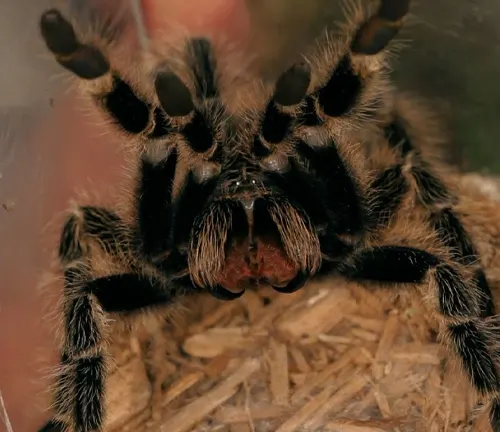
Keeping Mexican Red Knee Tarantulas as Pets
Enclosure Setup
Creating the ideal enclosure for a Mexican Red Knee Tarantula is essential for its well-being. Start with a spacious terrarium, preferably with a secure lid to prevent escapes. The substrate should be a mix of coconut fiber or peat moss, providing a suitable environment for burrowing. Add hiding spots such as cork bark or half logs for the tarantula to retreat to when it feels stressed. Ensure proper ventilation while maintaining humidity levels between 65% and 75%. A shallow water dish should be provided for drinking, but make sure it’s shallow to prevent drowning accidents.
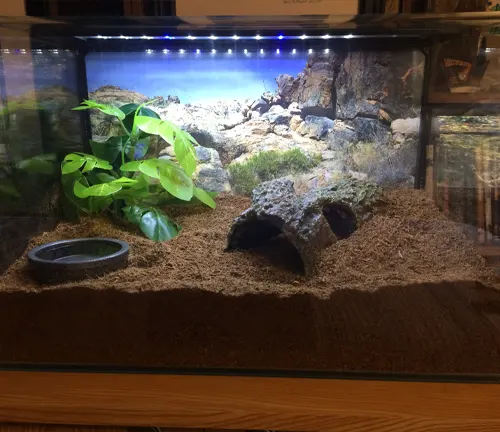
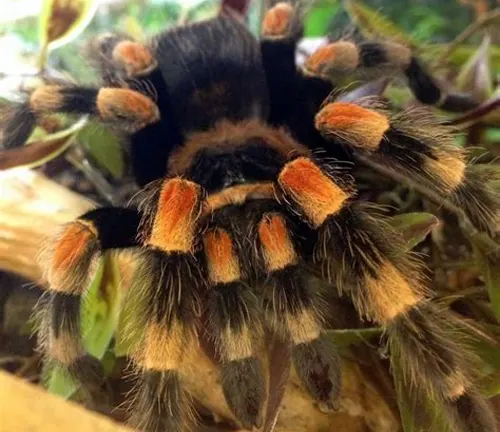
Feeding and Care
Feeding your Mexican Red Knee Tarantula a balanced diet is crucial for its health. Offer a variety of live insects such as crickets, mealworms, and roaches 2-3 times a week for adults, adjusting the frequency for juveniles accordingly. Gut-load feeder insects with nutritious foods before offering them to your tarantula. Remove uneaten prey items to prevent them from harming your pet. Additionally, maintain a clean enclosure by spot cleaning regularly and performing a complete substrate change every few months. Monitor temperature and humidity levels to ensure they remain within the recommended range.
Handling Tips
While Mexican Red Knee Tarantulas are generally docile, handling should be approached with caution and respect for the tarantula’s boundaries. Before attempting to handle your tarantula, wash your hands thoroughly to remove any scents that might alarm it. When picking up your tarantula, use gentle and deliberate movements, avoiding sudden gestures that may startle it. Support the tarantula’s body evenly and avoid squeezing or pressing on its abdomen. Keep handling sessions brief and infrequent to minimize stress for your tarantula. If your tarantula displays defensive behaviors such as raising its front legs or flicking urticating hairs, gently place it back into its enclosure and give it space to calm down.

Common Misconceptions and Myths
- Aggressiveness: One common misconception about Mexican Red Knee Tarantulas is that they are aggressive towards humans. In reality, these tarantulas are typically docile and will only bite if they feel threatened or provoked. Most encounters with Mexican Red Knee Tarantulas result in them retreating or adopting defensive postures rather than attacking.
- Deadly Venom: Another myth surrounding Mexican Red Knee Tarantulas is that their venom is highly toxic and potentially deadly. While they do possess venom, it is relatively mild and comparable to a bee sting in terms of its effects on humans. Tarantula venom is primarily used to immobilize prey rather than as a defense mechanism against larger predators like humans.
- Fast Growth: Some people believe that Mexican Red Knee Tarantulas grow rapidly and will quickly outgrow their enclosures. While they do undergo periodic molting to facilitate growth, their growth rate is relatively slow compared to other arachnid species. With proper care and maintenance, Mexican Red Knee Tarantulas can live for many years without the need for frequent enclosure upgrades.
- Indiscriminate Predators: There is a misconception that Mexican Red Knee Tarantulas will consume any prey item offered to them without discrimination. In reality, these tarantulas are selective feeders and may refuse certain prey items or prefer specific types of insects over others. It’s important for owners to observe their tarantula’s feeding preferences and adjust their diet accordingly.
- Escape Artists: While tarantulas are capable climbers, Mexican Red Knee Tarantulas are not notorious escape artists. With a properly secured enclosure and appropriate husbandry practices, the likelihood of a tarantula escaping is minimal. Ensuring that the enclosure has a secure lid and no gaps or openings where the tarantula could escape from is essential for preventing escapes.
Conservation Status
The conservation status of Mexican Red Knee Tarantulas is of concern due to habitat destruction and over-collection for the pet trade. While they are not currently listed as endangered, their populations have experienced declines in certain regions of their native range. The destruction of their natural habitat, primarily through deforestation and urbanization, poses a significant threat to their survival. Additionally, the demand for Mexican Red Knee Tarantulas in the exotic pet trade has led to unsustainable harvesting from the wild.
Efforts to conserve Mexican Red Knee Tarantulas include habitat protection measures, such as establishing protected areas and promoting sustainable land management practices. Furthermore, regulations on the collection and trade of wild-caught specimens have been implemented to prevent over-exploitation. Conservation organizations and researchers continue to study the ecology and behavior of Mexican Red Knee Tarantulas to inform conservation strategies and ensure their long-term viability in the wild.
Different Species
Brachypelma albiceps
Also known as the Mexican Golden Red Rump, this species is similar in appearance to the Mexican Red Knee Tarantula but with a golden-red rump instead of red knees.
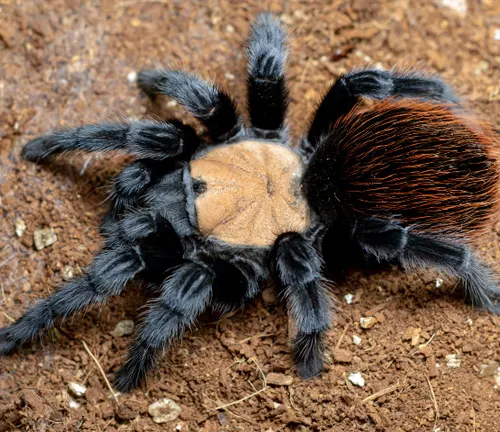

Brachypelma auratum
Commonly referred to as the Mexican Flame Knee, this species features bright orange-red markings on its knees and a striking black body.
Brachypelma baumgarteni
Known as the Mexican Pink Tarantula, this species exhibits pinkish hues on its legs and abdomen, making it visually distinct from its relatives.
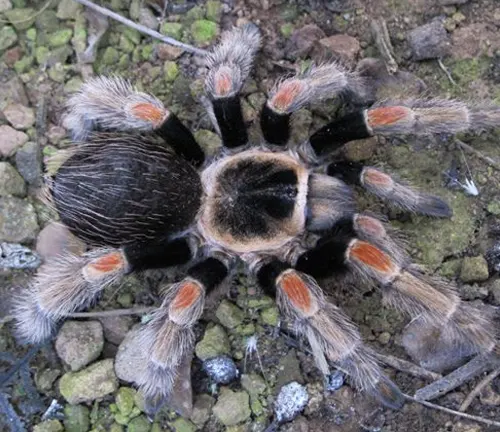
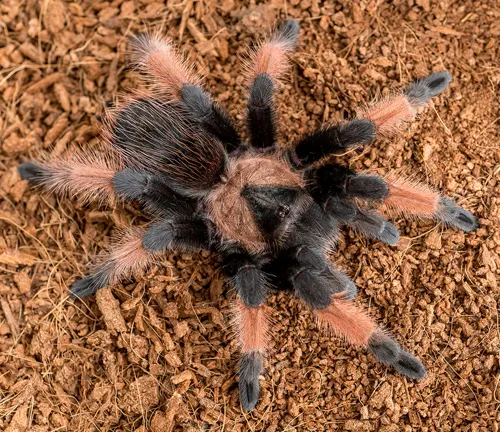
Brachypelma emilia
The Mexican Red Leg Tarantula, characterized by red-orange coloration on its legs and abdomen, is another close relative of the Mexican Red Knee Tarantula.
Brachypelma klaasi
Often called the Mexican Pink Beauty, this species displays vibrant pink hues on its legs and abdomen, making it highly sought after by collectors.

Frequently Asked Questions (FAQs)
- Are Mexican Red Knee Tarantulas venomous?
Mexican Red Knee Tarantulas possess venom, but it is relatively mild and not considered dangerous to humans. - How often should I feed my Mexican Red Knee Tarantula?
It’s recommended to feed adult Mexican Red Knee Tarantulas 2-3 times a week, while juveniles may require feeding more frequently. - Do Mexican Red Knee Tarantulas make good pets for beginners?
Yes, Mexican Red Knee Tarantulas are often recommended as suitable pets for beginners due to their docile nature and relatively low maintenance requirements. - What substrate is best for Mexican Red Knee Tarantula enclosures?
Substrates such as coconut fiber or peat moss are commonly used for Mexican Red Knee Tarantula enclosures, providing a suitable environment for burrowing. - How do I know if my Mexican Red Knee Tarantula is molting?
Signs of molting in Mexican Red Knee Tarantulas include decreased appetite, increased lethargy, and a dull, darkened appearance of the exoskeleton. - Can Mexican Red Knee Tarantulas be housed together?
It’s generally not recommended to house Mexican Red Knee Tarantulas together, as they are solitary creatures and may become aggressive towards each other. - What temperature and humidity levels are ideal for Mexican Red Knee Tarantulas?
Mexican Red Knee Tarantulas thrive in temperatures ranging from 75°F to 85°F with humidity levels between 65% and 75%. - How do I handle my Mexican Red Knee Tarantula safely?
When handling Mexican Red Knee Tarantulas, it’s important to approach them calmly and gently support their body to avoid causing stress or injury. - What are the signs of illness in Mexican Red Knee Tarantulas?
Signs of illness in Mexican Red Knee Tarantulas may include lethargy, loss of appetite, abnormal webbing behavior, or visible abnormalities on the body. - Do Mexican Red Knee Tarantulas require supplemental heating?
In most cases, room temperature is sufficient for Mexican Red Knee Tarantulas, but supplemental heating may be necessary in colder climates or during winter months. - Can Mexican Red Knee Tarantulas regrow lost limbs?
Yes, Mexican Red Knee Tarantulas have the ability to regenerate lost limbs through a process called molting, where they shed their exoskeleton and grow a new limb during subsequent molts. - Are Mexican Red Knee Tarantulas aggressive towards humans?
Mexican Red Knee Tarantulas are generally docile and not aggressive towards humans unless provoked or threatened.





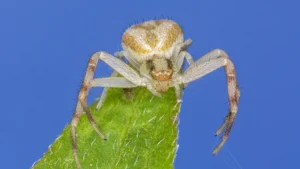
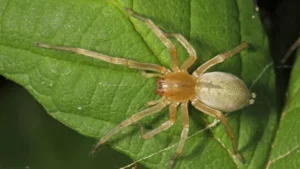



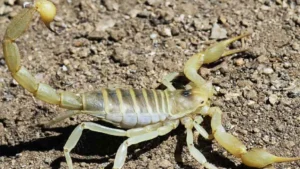


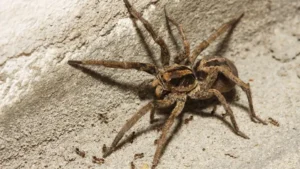
Leave your comment